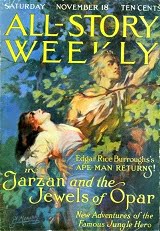
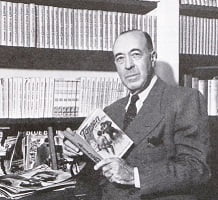 Tarzan, Lord of the Jungle (1951-1952) aired “The End of the World” on March 8, 1951 as the 9th of its 75 episodes. For newcomers, we repeat the introduction to our previous Tarzan episode from July of 2019, almost a year ago: From 1932-36 Tarzan on radio consisted of three long-running serials: Tarzan of the Apes, Tarzan and the Diamond of Asher, and The Fires of Toth. Tarzan was played by silent film actor James H. Pierce and Jane was played by Edgar Rice Burroughs’s daughter Joan. Pierce had attended a party held by Burroughs where he met Joan. ERB asked Pierce if would appear as Tarzan in ERB’s next silent Tarzan picture. Pierce replied that he was to appear in another film titled Wings. ERB nevertheless convinced Pierce to become Tarzan and he gave up his role in Wings. Pierce’s role in Wings was then filled by a relative newcomer named Gary Cooper, and Wings would walk away with the first Oscar for what is now known as Best Picture in 1929. Such blow the fickle winds of Fate. On the up side, James Pierce would wed Joan Burroughs in 1928 and they would remain together until their deaths (Joan in 1972 and James in 1983).
Tarzan, Lord of the Jungle (1951-1952) aired “The End of the World” on March 8, 1951 as the 9th of its 75 episodes. For newcomers, we repeat the introduction to our previous Tarzan episode from July of 2019, almost a year ago: From 1932-36 Tarzan on radio consisted of three long-running serials: Tarzan of the Apes, Tarzan and the Diamond of Asher, and The Fires of Toth. Tarzan was played by silent film actor James H. Pierce and Jane was played by Edgar Rice Burroughs’s daughter Joan. Pierce had attended a party held by Burroughs where he met Joan. ERB asked Pierce if would appear as Tarzan in ERB’s next silent Tarzan picture. Pierce replied that he was to appear in another film titled Wings. ERB nevertheless convinced Pierce to become Tarzan and he gave up his role in Wings. Pierce’s role in Wings was then filled by a relative newcomer named Gary Cooper, and Wings would walk away with the first Oscar for what is now known as Best Picture in 1929. Such blow the fickle winds of Fate. On the up side, James Pierce would wed Joan Burroughs in 1928 and they would remain together until their deaths (Joan in 1972 and James in 1983).
(Above left: All-Story Weekly, November 18, 1916, featuring “Tarzan and the Jewels of Opar” – Above Right: ERB, 1875-1950)
(Photo below left: Joan and James Pierce photo cropped to show the left half of their wedding invitation, dated August 8, 1928. From the Danton Burroughs Archive Collection.)
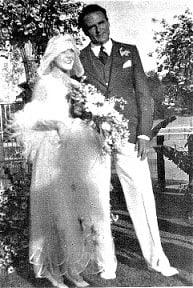 It is impractical to run lengthy serials here, though we have run a few consecutive episodes with specific self-contained adventures. Each of the 1930s Tarzan serials ran to approximately 40 episodes, give or take, and timed out from 8-12 minutes each. There would be a new Tarzan episode in the much longer story arc every two or three days throughout the week. After the trio of initial serials in the 1930s, the Golden Age of radio would produce no further Tarzan adventures until 1951, at which time his new exploits would run from January of 1951 through June of 1952 (and through July of 1953 if one counts syndicated rebroadcasts), when many radio shows were gradually being phased out in favor of television. Lamont Johnson now played the Lord of the Jungle, and in contrast to the earlier 1930s serials (and the famous Johnny Weismuller Tarzan films), Tarzan would speak intelligent English rather than the “Me Tarzan, you Jane” dialogue many have come to think of when the subject comes up.
It is impractical to run lengthy serials here, though we have run a few consecutive episodes with specific self-contained adventures. Each of the 1930s Tarzan serials ran to approximately 40 episodes, give or take, and timed out from 8-12 minutes each. There would be a new Tarzan episode in the much longer story arc every two or three days throughout the week. After the trio of initial serials in the 1930s, the Golden Age of radio would produce no further Tarzan adventures until 1951, at which time his new exploits would run from January of 1951 through June of 1952 (and through July of 1953 if one counts syndicated rebroadcasts), when many radio shows were gradually being phased out in favor of television. Lamont Johnson now played the Lord of the Jungle, and in contrast to the earlier 1930s serials (and the famous Johnny Weismuller Tarzan films), Tarzan would speak intelligent English rather than the “Me Tarzan, you Jane” dialogue many have come to think of when the subject comes up.
We have run 7 consecutively numbered episodes from the 1932-36 era, and this is the 12th from the modern 1951-52 era.
As for “The End of the World,” it’s another of those stories where someone or some corporation is attempting to exploit Africa’s many riches and uses the naive natives toward that end. This time a pseudo-magician uses his cheap tricks to swindle the natives out of their precious gems and gold by using modern, scientific knowledge of the weather as leverage over their religious beliefs, which have recently been converted to Christianity due to the efforts of a devoted missionary. Trying to help, Tarzan runs into more trouble than he bargained for, and is severely wounded as he tries to stop “The End of the World.”
Play Time: 26:11
{March of 1951 once again found the United States (as part of a U.N. effort) at war, this time in South Korea. Communist North Korea (with help from the Russians) invaded South Korea in June of 1950, beginning what would be called the “Korean Conflict,” a war that was not officially a war and that would last into 1953. As a refuge from real world troubles, the neighborhood gang relished even more than before their visits to the corner newsstand, there to find colorful adventures to other times and places. Astounding SF (1930-present, now Analog) was a cornerstone and a must buy, especially when it featured cover stories by the likes of James H. Schmitz. It held to its long-standing monthly schedule in 1951. Relative newcomer Galaxy (1950-1980) was coming into its own as a breath of fresh air for the field in terms of subject matter, welcoming long-established mainstays such as Lester del Rey to grace its forward-looking approach to the SF genre with new material. It too was a monthly in 1951. Ray Palmer’s Other Worlds (1949-1953) was to be the SFnal counterpoint to his UFO fact magazine Fate, but as was the case with several other of Palmer’s genre publishing efforts, it ran into financial difficulties and was short-lived, with Palmer shifting his capital to yet two other new magazines after folding Other Worlds (Science Stories and Universe Science Fiction, the former lasting but 4 issues and the latter a slightly better 10 issues). Other Worlds ran some interesting material from time to time but was never a major force in the field. It was bi-monthly in 1951.]
[Left: Astounding, March 1951 – Center: Galaxy, March 1951 – Right: Other Worlds, March 1951]
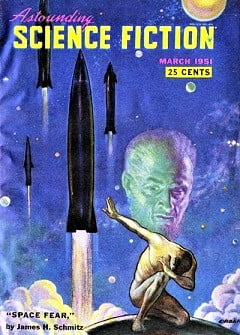
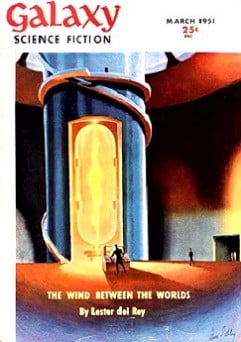
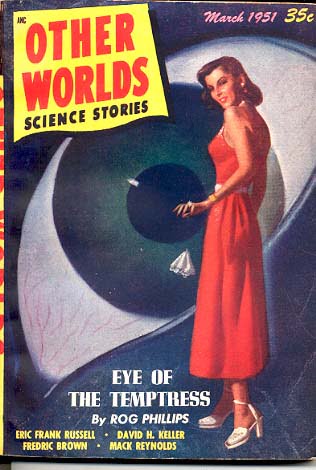
To view the entire list of weekly Old Time Radio episodes at Tangent Online, click here.